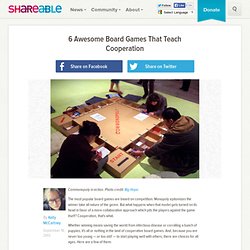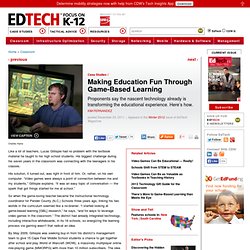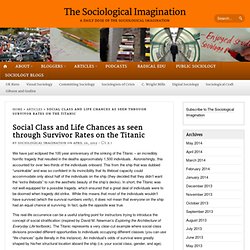

6 Awesome Board Games That Teach Cooperation. Commonopoly in action.

Photo credit: Big Hope. The most popular board games are based on competition. Monopoly epitomizes the winner take all nature of the genre. But what happens when that model gets turned on its head in favor of a more collaborative approach which pits the players against the game itself? Cooperation, that's what. Whether winning means saving the world from infectious disease or corralling a bunch of puppies, it's all or nothing in the land of cooperative board games.
Commonopoly Object of Game: This oversized board game was inspired by the classic Monopoly, though not without a collaborative spin. Target Age: 12+ Number of Players: 2-4 Co-opoly Object of Game: Players work together to establish — and then run — a democratic business with all of the challenges inherent in such an endeavor. Target Age: 13+Number of Players: 2-4 Pandemic Object of Game: Here, players unite against four diseases with a goal of eradication. Space Alert. Titanic. Titanic. Making Education Fun Through Game-Based Learning. Like a lot of teachers, Lucas Gillispie had no problem with the textbook material he taught to his high school students.

His biggest challenge during his seven years in the classroom was connecting with the teenagers in his classes. His solution, it turned out, was right in front of him. Or, rather, on his own computer. “Video games were always a point of connection between me and my students,” Gillispie explains. “It was an easy topic of conversation — the spark that got things started for me at school.”
So when the game-loving teacher became the instructional technology coordinator for Pender County (N.C.) By May 2009, Gillispie was seeking buy-in from his district’s management team to give 15 Cape Fear Middle School students a chance to get together after school and play World of Warcraft (WOW), a massively multiplayer online role-playing game (MMORPG) with more than 10 million subscribers.
“We saw amazing things,” Gillispie says. SOURCE: Pew Internet & American Life Project. » Social Class and Life Chances as seen through Survivor Rates on the Titanic The Sociological Imagination. We have just eclipsed the 100 year anniversary of the sinking of the Titanic – an incredibly horrific tragedy that resulted in the deaths approximately 1,500 individuals.

Astonishingly, this accounted for over two-thirds of the individuals onboard. This from the ship that was dubbed “unsinkable” and was so confident in its invincibility that its lifeboat capacity could accommodate only about half of the individuals on the ship (they decided that they didn’t want the “extra lifeboats” to ruin the aesthetic beauty of the ship’s decks). In short, the Titanic was not well-equipped for a possible tragedy, which ensured that a great deal of individuals were to be doomed when tragedy did strike. While this means that most of the individuals wouldn’t have survived (which the survival numbers verify), it does not mean that everyone on the ship had an equal chance at surviving. In fact, quite the opposite was true. Here is an interesting chart illustrating the survivor rates by gender and class: Anthropological Video Games. A cluster of teen-agers gathered around a small table, and passersby could hear them exclaim, “Asian!

Yeah, I knew it!” And “Aryan? That seems ridiculous.” They hovered over two iPads in the Grand Gallery of the Museum of Natural History during the Margaret Mead Film Festival, playing a game called “Guess My Race.” It was one of five video games in the Mead Arcade; the others included “The Cat and the Coup,” which traces the downfall of Iran’s first democratically elected Prime Minister, Mohammad Mossadegh, and “Sweatshop,” in which you hire and fire workers for your loathsome factory. Aiding the swarms of museum patrons who stopped to play were volunteers from Games for Change, a New York City-based nonprofit that encourages the development of what it calls “social-impact games.” I selected an adult worker, rather than a child, to box up hats on the assembly line, and asked the volunteer, “Do you find that most people choose children to work?” “By the end, you have to,” she said.
Trading Races. RACE - The Power of an Illusion . Sorting People. Ed games.